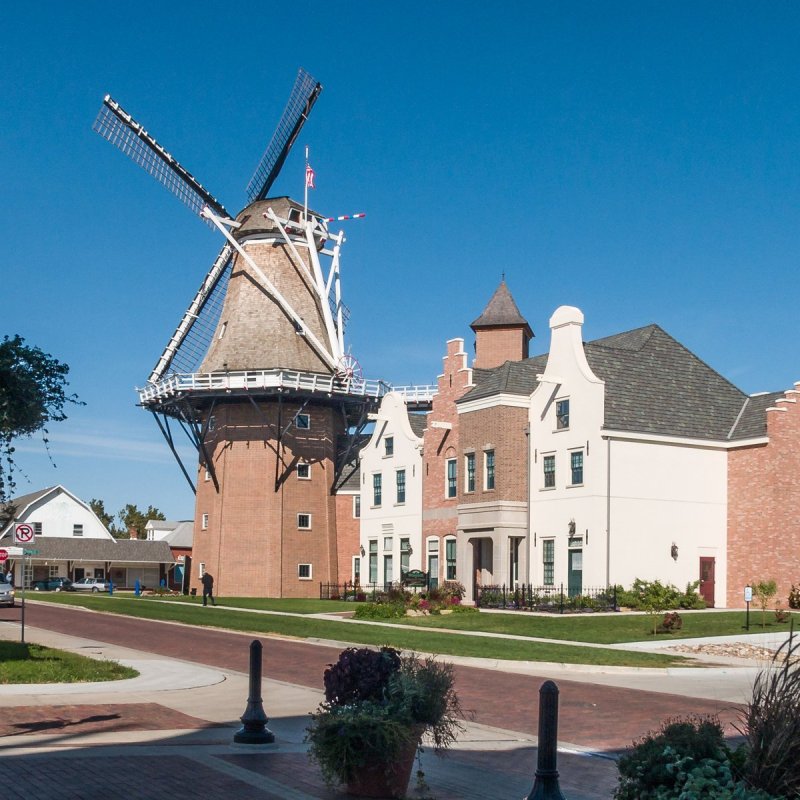
Have you ever considered what it would be like to visit Europe without boarding a plane or taking a transatlantic cruise? How’s that possible, you ask? Well, in Iowa, you can visit eight countries without leaving the Hawkeye State. European immigrants often found areas of the state that reminded them of their homeland, so it seemed a natural fit to settle in Iowa. Here’s where to visit European Iowa without a passport.
Videos by TravelAwaits
1. Decorah
Enjoy a taste of Norway during a visit to Decorah. The northeast Iowa community celebrates its heritage each July with Nordic Fest, a three-day event that includes a parade, traditional dances, and great food, such as lefse. You can explore the city’s Norwegian heritage year-round with a visit to the Vesterheim, home to the 25-foot-long Tradewind, a sailboat that carried two brothers across the ocean to the United States. The museum celebrates Norwegian emigration to the U.S. and includes artifacts and memorabilia, such as ale buckets and kitchen utensils. The museum explores Scandinavian religion, from a stave church to contemporary Lutheran churches. Outside, a living history community includes houses, a schoolhouse, and a mill.

2. Elk Horn
Home to a nearly two-century-old windmill imported from Denmark, Elk Horn, along with nearby Kimballton, is home to one of the largest rural Danish settlements in the United States. The 1848 Danish windmill was taken apart in Norway and reassembled in Elk Horn. Visitors can climb to the top floor of the windmill and get a view into the life of a miller. The Museum of Danish America is home to an impressive collection of artifacts related to Danish immigration, including dolls, needles, weapons, pipes, and clothes. Its permanent exhibits include a LEGO display (LEGO is a Danish institution), and it has many special exhibits. The museum manages a genealogy center in downtown Elk Horn that has helped thousands of people from around the country connect with their Danish roots.
Each summer, the town celebrates its heritage with Tivoli Fest, and then the Christmas season with Julefest.
A five-minute drive north of Elk Horn, Kimballton is home to a replica of The Little Mermaid statue of Copenhagen. It’s in a small sculpture park that highlights the stories of Hans Christian Andersen.
While in Elk Horn, head to The Danish Table: A Hygge Kitchen for authentic Scandinavian food. Enjoy a side of red cabbage and potatoes with gravy alongside frikadeller (Danish meatballs), sausage, or salted pork belly (considered Denmark’s national dish) for an amazing dinner. Breakfast includes aebleskiver, a baked ball of dough, along with toppings of jam, butter, or syrup. The Kringle Man is known for his freshly-baked kringles, which are layers of dough stuffed with apple and strawberry. They are sold at the main street store as well as local outlets.
3. Amana Colonies
Located midway between Des Moines and Iowa City, the Amana Colonies’ seven villages celebrate their German heritage through museums, festivals, and buildings. The Colonies looked to their past when constructing buildings from sandstone, brick, and wood. Adding to the German influence, the villages that make up the Amana Colonies offer a communal feel.
Amana Furniture and Clock Shop is known for its high-quality handcrafted furniture. With an assortment of food and other items, the High Amana General Store is both a museum and working store. The Millstream Brewing Company produces craft beer that beckons to original German brews. As the first microbrewery in Iowa, Millstream continues to be recognized as one of the best in the state.
Enjoy traditional German dishes, such as schnitzels served with spaetzle and potatoes and sauerbraten served with dumplings, at the Ox Yoke Inn. The Ronneburg Restaurant also features authentic German fare, including Jagerschnitzel and hahnchenschnitzel as well as wienerschnitzel. If you’ve been to Germany, you’ll have fun flashbacks dining at these restaurants.
With six festivals, the Amana Colonies are the place to learn about history and culture. From Maifest to Oktoberfest and Tannenbaum Forest, you’ll have a wonderful time soaking in the fun.
4. Pella
A visit to Pella during Tulip Time may remind you of visiting the Netherlands. The colorful flowers dot the Dutch town’s landscape as locals welcome visitors to celebrate their heritage. With a parade, food, and music, Tulip Time is a must-see in early May. Enjoy a taste of the Netherlands with a bologna sausage (similar to a corn dog) and a stroopwafel for dessert.
Pella also showcases its history throughout the year as you make your way through the windmill and historical village, which includes the childhood home of famous cowboy sheriff Wyatt Earp. Molengracht Plaza is home to a Dutch-style canal that runs through the retail area, and it features buildings that resemble the architecture you may find in Europe. Daily performances of handcrafted characters highlight the Klokkenspel, which anchors a plaza with flowers, benches, and tile mosaics highlighting Dutch history.

5. Cedar Rapids
Home to the National Czech and Slovak Museum and Library, Cedar Rapids is ground zero for Czech history and culture in Iowa. With interactive exhibits, you’ll learn about Czech and Slovak immigration to the United States and what life was like in 19th century Europe. With a look at traditional clothing and what an immigrant house may look like, you’ll see how Czechs maintained their connection to the homeland while assimilating to life in the United States. The museum rotates exhibits and also hosts special exhibits.
6. Stanton
With the world’s largest coffee pot located nearby, the Swedish Heritage and Cultural Center celebrates Stanton’s Scandinavian history. Located in a former school building, the heritage center showcases the community’s Swedish culture with exhibits highlighting a school classroom, children’s home, town baseball, and area farming. Other artifacts include photographs that detail the town’s history back to the 19th century.
7. Waterloo
Waterloo transforms into O’Waterloo each August as nearly 50,000 people visit Irish Fest, one of the most popular Irish celebrations in the Midwest. Featuring traditional Irish music, dances, food, and drink, downtown’s Lincoln Park is packed with festival goers. Visitors can learn about Irish traditions, such as weaving.
8. Corning
It’s rare to find a French museum in the Midwest, so Corning’s French Icarian Village is a must-see. A living history museum that continues to be developed over 34 acres, the village is located on actual French Icarian land. Icarians were a Utopian-based group of socialists who followed the beliefs of Etienne Cabet, a journalist and politician. Icarian villages were primarily located in Iowa, Missouri, Texas, and California. The Corning village was the last one to fade away. During your visit, check out the Icarian cemetery, communal dining hall, and schoolhouse.
9. Manning
Manning is home to a rare German hausbarn in the United States. Built in 1660, the hausbarn was transported to the United States and reassembled in Manning in 1996. The hausbarn contained everything a German farm family needed, from living quarters to livestock housing and equipment storage. At Hausbarn Heritage Park, you’ll also find antique farm equipment, an early 20th-century farmstead, an 1884 Lutheran church, and the Carroll County Freedom Rock, an art piece honoring area veterans.
10. Emmetsburg
Everyone’s Irish in Emmetsburg — at least for a day as the northwest Iowa community celebrates its Irish Festival around St. Patrick’s Day. The four-day March event attracts people from around Iowa and surrounding states as a parade down its main street highlights a weekend of activities. Get your Irish on with a baked potato bar, Guinness cook-off, and pancake feed. Other activities include a talent show, community concert, caricature artist, and a chainsaw artist.

11. Orange City
Orange City puts the fest in its Tulip Festival. One of the best summer festivals in Iowa, the Orange City Tulip Festival attracts thousands of visitors to the northwest Iowa community. As one of the most outstanding — and longest — parades you’ll see, it kicks off with a team of men and boys, dressed in traditional clothing, washing down the parade route with buckets of water taken from a cow tank. Often, though, more water ends up on the group (and some parade watchers) than on the street. The water that is splashed on the street is then swept up a team of women and girls pushing brooms. Then the festivities begin with high school marching bands, Dutch dancers wearing traditional garb, and floats. Orange City’s high school band marches wearing wooden shoes, a symbol of the city’s Dutch history.
The Tulip Festival also features several community activities. There is a shoemaker who works on wooden footwear using vintage equipment. A straatmarkt (street market) features a variety of merchants and vendors selling all kinds of wares.
While you enjoy the sights and sounds, you may encounter a team of bicyclists who abruptly stop and sing Dutch songs for festival-goers. And don’t forget the food! The Orange City event offers delicious treats, such as poffertjes, small pancakes with powdered sugar.
While everyone enjoys the three-day festival, Orange City invites you to tour attractions throughout the year. A walking tour (PDF) features dozens of attractions, including 5 windmills and Dutch-style decorative shutters at the county treasurer’s office.
